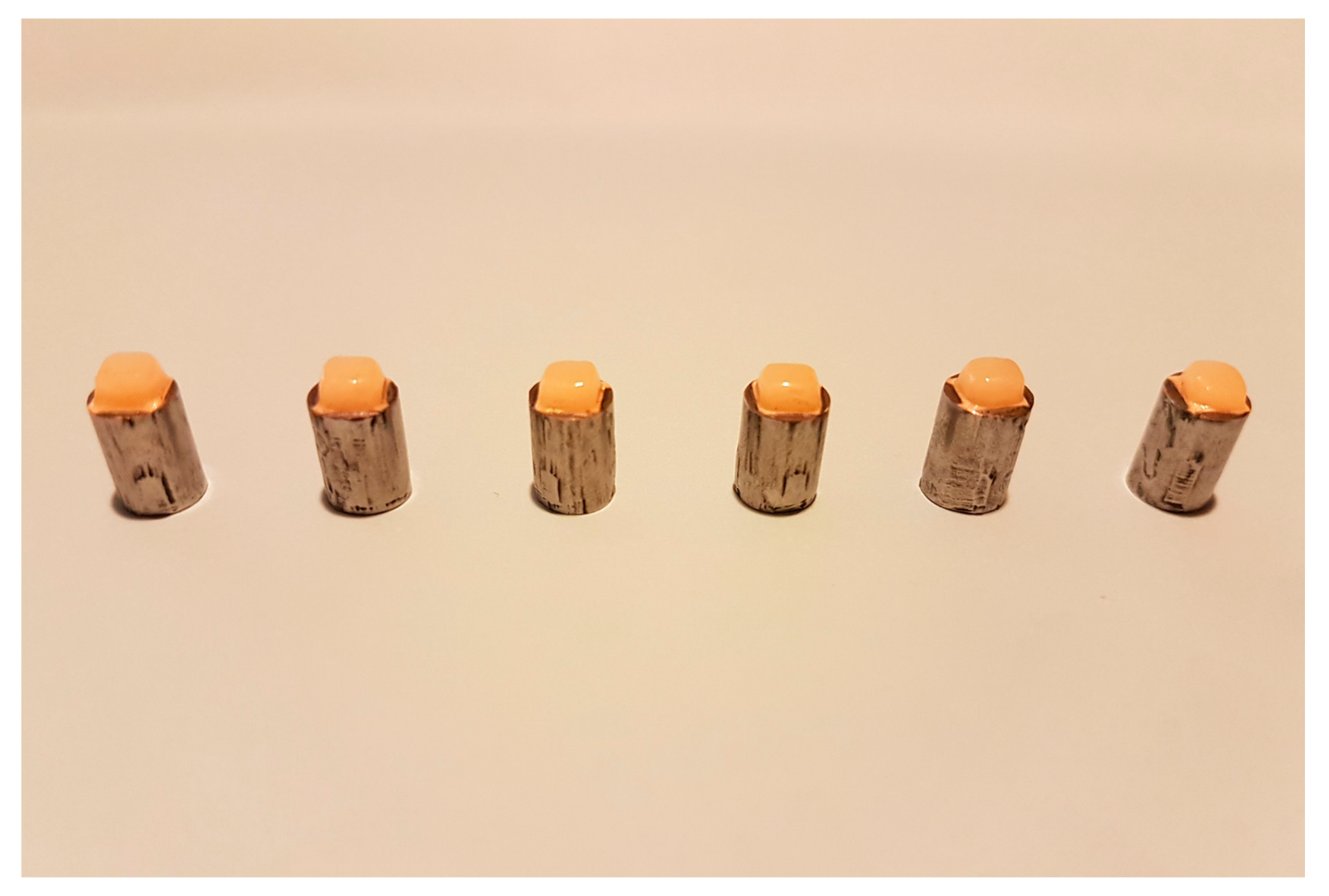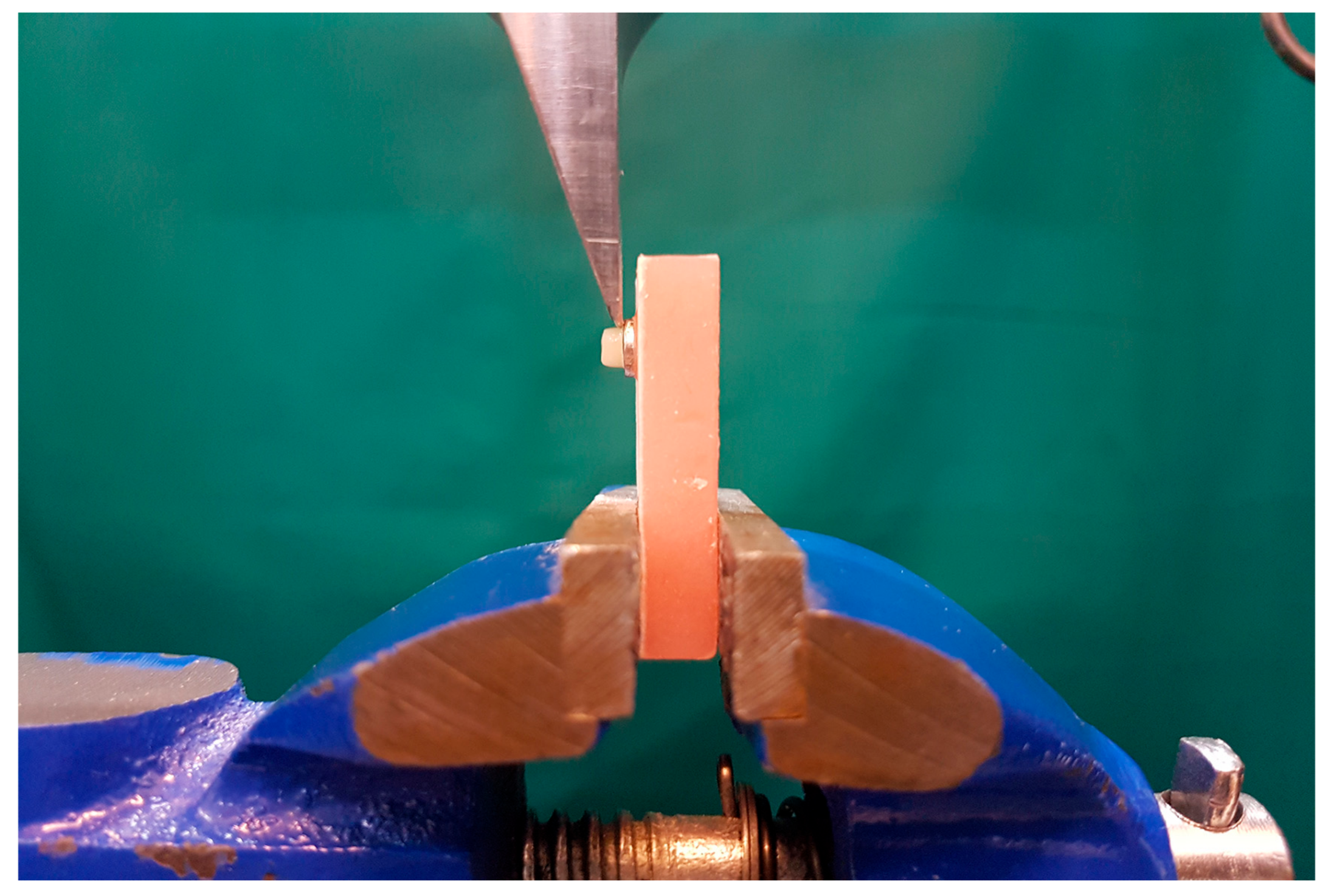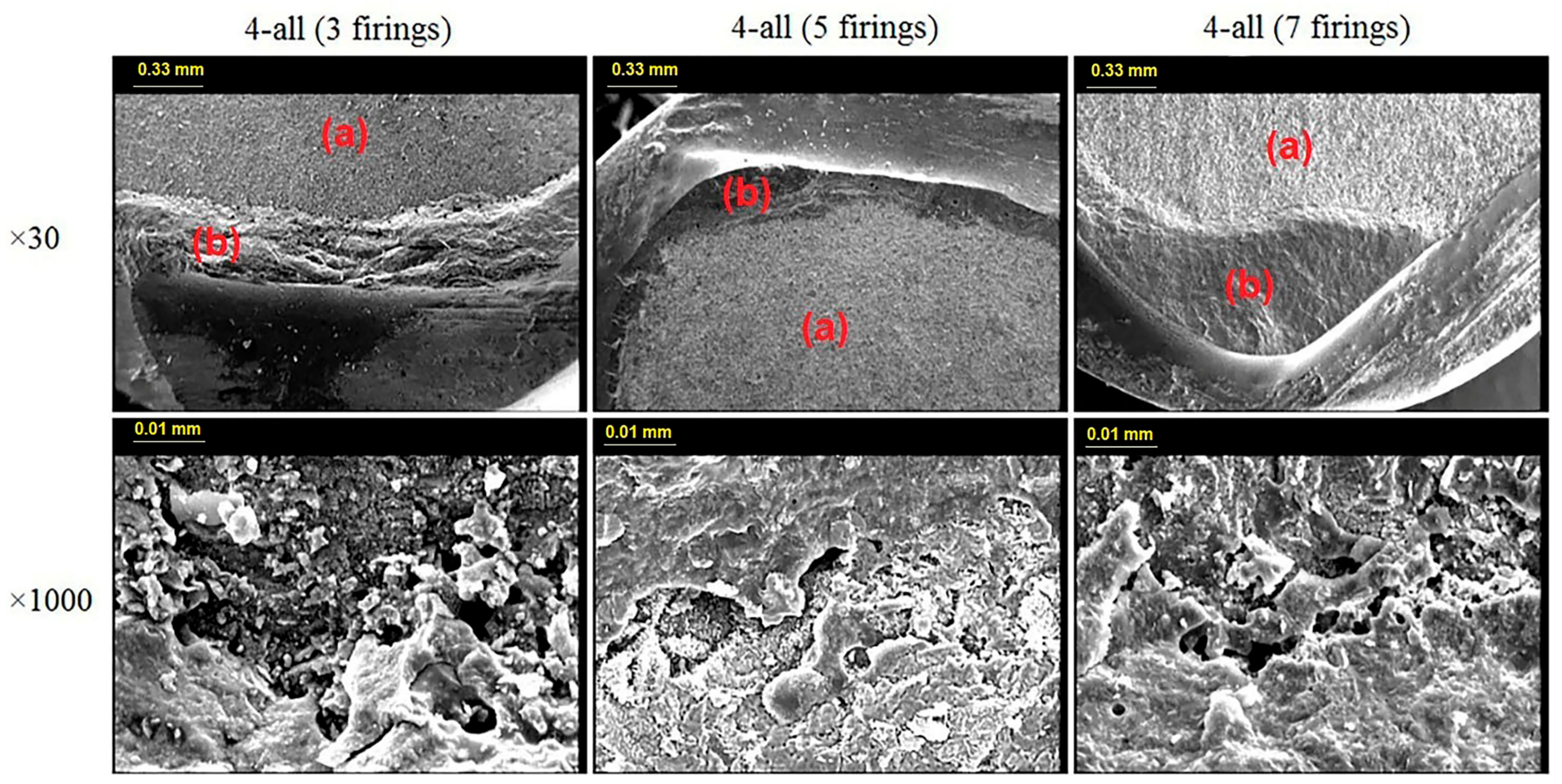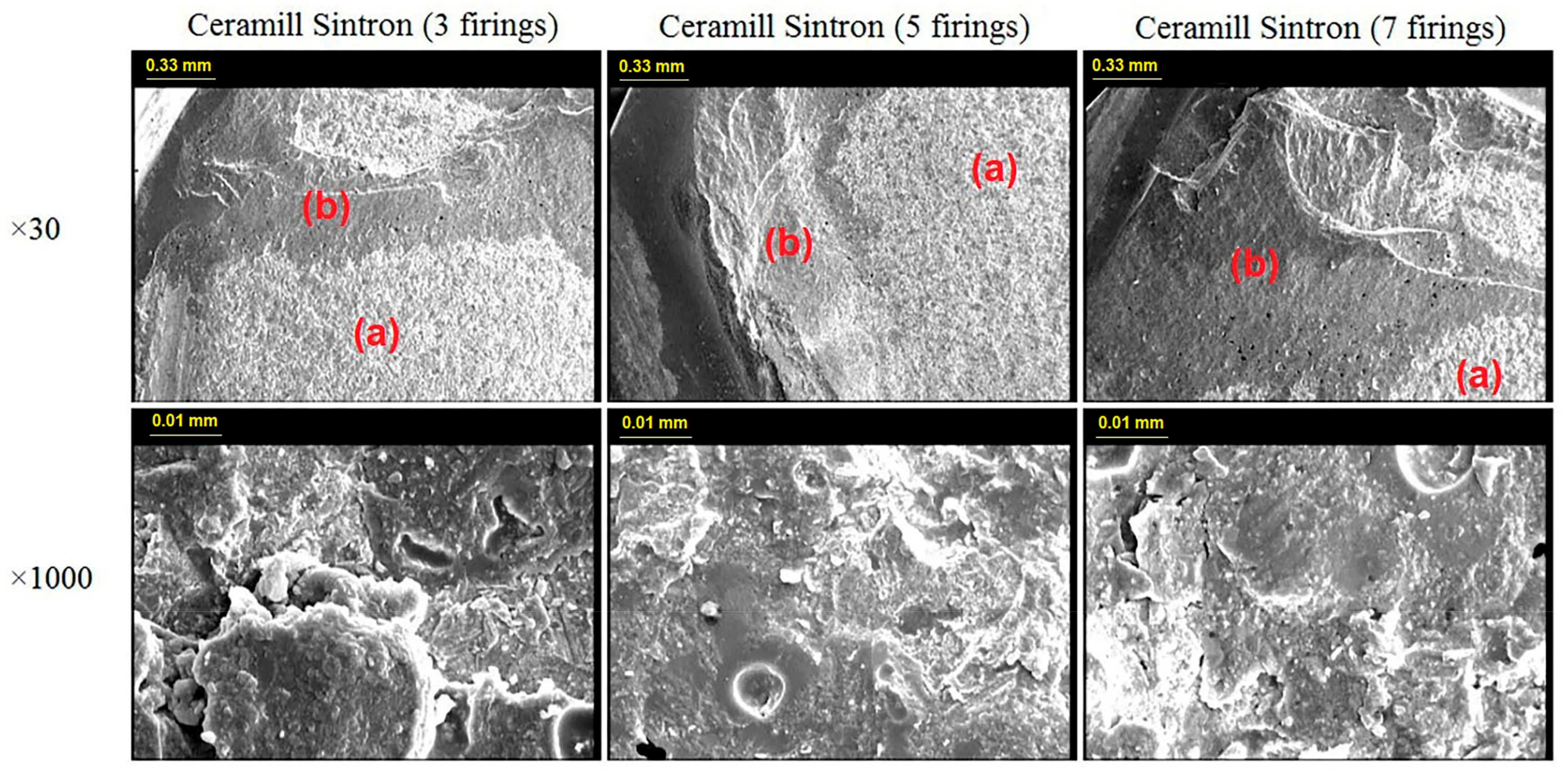The Effect of Multiple Firings on the Shear Bond Strength of Porcelain to a New Millable Alloy and a Conventional Casting Alloy
Abstract
:1. Introduction
2. Materials and Methods
3. Results
4. Discussion
5. Conclusions
Acknowledgments
Author Contributions
Conflicts of Interest
References
- Wataha, J.C.; Messer, R.L. Casting alloys. Dent. Clin. N. Am. 2004, 48, 499–512. [Google Scholar] [CrossRef] [PubMed]
- Williams, T.R.P. A Study of Base Metal-Ceramic Interface Reactions. Master’s Thesis, Indiana University, Bloomington, Indiana, 1976. [Google Scholar]
- Lubovich, R.P.; Goodkind, R.J. Bond strength studies of precious, semiprecious, and nonprecious ceramic-metal alloys with two porcelains. J. Prosthet. Dent. 1977, 37, 288–299. [Google Scholar] [CrossRef]
- Sakaguchi, R.L.; Powers, J.M. Craig’s Restorative Dental Materials, 13th ed.; Elsevier Mosby: St. Louis, MO, USA, 2012; pp. 176–178. [Google Scholar]
- Roach, M. Base metal alloys used for dental restorations and implants. Dent. Clin. N. Am. 2007, 51, 603–627. [Google Scholar] [CrossRef] [PubMed]
- Covington, J.; McBride, M.; Slagle, W.; Disney, A. Quantization of nickel and beryllium leakage from base metal casting alloys. J. Prosthet. Dent. 1985, 54, 127–136. [Google Scholar] [CrossRef]
- Hildebrand, H.F.; Veron, C.; Martin, P. Nickel, chromium, cobalt dental alloys and allergic reactions: An overview. Biomaterials 1989, 10, 545–548. [Google Scholar] [CrossRef]
- Geis-Gerstorfer, J.; Sauer, K.H.; Pässler, K. Ion release from Ni-Cr-Mo and Co-Cr-Mo casting alloys. Int. J. Prosthodont. 1991, 4, 152–158. [Google Scholar] [PubMed]
- Bumgardner, J.D.; Lucas, L.C. Cellular response to metallic ions released from nickel-chromium dental alloys. J. Dent. Res. 1995, 74, 1521–1527. [Google Scholar] [CrossRef] [PubMed]
- Qiu, J.; Yu, W.Q.; Zhang, F.Q.; Smales, R.J.; Zhang, Y.L.; Lu, C.H. Corrosion behaviour and surface analysis of a Co–Cr and two Ni–Cr dental alloys before and after simulated porcelain firing. Eur. J. Oral. Sci. 2011, 119, 93–101. [Google Scholar] [CrossRef] [PubMed]
- Wataha, J.C. Alloys for prosthodontic restorations. J. Prosthet. Dent. 2002, 87, 351–363. [Google Scholar] [CrossRef] [PubMed]
- McLaren, E.A.; Terry, D.A. CAD/CAM systems, materials, and clinical guidelines for all-ceramic crowns and fixed partial dentures. Compend. Cont. Educ. Dent. 2002, 23, 637–641. [Google Scholar]
- Noack, F. Quickly milled, reliably veneered. Dent. Dialog. 2012, 13, 6–11. [Google Scholar]
- Zimmermann, R.; Seitz, S.; Magness, B.; Wieck, B. Using CAD/CAM technology to create a 10-unit zirconia fixed partial denture—A UTHSCSA dental school case report. Tex. Dent. J. 2013, 130, 1039–1044. [Google Scholar] [PubMed]
- Yoon, T.H.; Madden, J.C.; Chang, W.G. A technique to restore worn denture teeth on a partial removable dental prosthesis by using ceramic onlays with CAD/CAM technology. J. Prosthet. Dent. 2013, 110, 331–332. [Google Scholar] [CrossRef]
- De Araujo, G.M.; de Franca, D.G.; Silva Neto, J.P.; Barbosa, G.A. Passivity of conventional and CAD/CAM fabricated implant frameworks. Braz. Dent. J. 2015, 26, 277–283. [Google Scholar] [CrossRef] [PubMed]
- Real-Voltas, F.; Romano-Cardozo, E.; Figueras-Alvarez, O.; Brufau-de Barbera, M.; Cabratosa-Termes, J. Comparison of the marginal fit of cobalt-chromium metal-ceramic crowns fabricated by CAD/CAM techniques and conventional methods at three production stages. Int. J. Prosthodont. 2017, 30, 304–305. [Google Scholar] [CrossRef] [PubMed]
- Rai, R.; Kumar, S.A.; Prabhu, R.; Govindan, R.T.; Tanveer, F.M. Evaluation of marginal and internal gaps of metal ceramic crowns obtained from conventional impressions and casting techniques with those obtained from digital techniques. Indian J. Dent. Res. 2017, 28, 291–297. [Google Scholar] [PubMed]
- Joias, R.M.; Tango, R.N.; de Araujo, J.E.J.; de Araujo, M.A.J.; Saavedra, G.d.S.F.A.; Paes-Junior, T.J.; Kimpara, E.T. Shear bond strength of a ceramic to Co-Cr alloys. J. Prosthet. Dent. 2008, 99, 54–59. [Google Scholar] [CrossRef]
- De Melo, R.M.; Travassos, A.C.; Neisser, M.P. Shear bond strengths of a ceramic system to alternative metal alloys. J. Prosthet. Dent. 2005, 93, 64–69. [Google Scholar] [CrossRef] [PubMed]
- Korkmaz, T.; Asar, V. Comparative evaluation of bond strength of various metal–ceramic restorations. Mater. Des. 2009, 30, 445–451. [Google Scholar] [CrossRef]
- Lopes, S.C.; Pagnano, V.O.; Rollo, J.M.D.d.A.; Leal, M.B.; Bezzon, O.L. Correlation between metal-ceramic bond strength and coefficient of linear thermal expansion difference. J. Appl. Oral. Sci. 2009, 17, 122–128. [Google Scholar] [CrossRef] [PubMed] [Green Version]
- Lacy, A.M. The chemical nature of dental porcelain. Dent. Clin. N. Am. 1977, 21, 661–667. [Google Scholar] [PubMed]
- Pretti, M.; Hilgert, E.; Bottino, M.A.; Avelar, R.P. Evaluation of the shear bond strength of the union between two CoCr-alloys and a dental ceramic. J. Appl. Oral. Sci. 2004, 12, 280–284. [Google Scholar] [CrossRef] [PubMed]
- Nelson, D.R.; Palik, J.F.; Morris, H.F.; Comella, M.C. Recasting a nickel-chromium alloy. J. Prosthet. Dent. 1986, 55, 122–127. [Google Scholar] [CrossRef]
- Issac, L.; Bhat, S. Effect of re-using nickel-chromium alloy on its ultimate tensile strength, yield strength and modulus of elasticity. Indian J. Dent. Res. 1998, 9, 13–17. [Google Scholar] [PubMed]
- Yilmaz, H.; Dincer, C. Comparison of the bond compatibility of titanium and anNiCr alloy to dental porcelain. J. Dent. 1999, 27, 215–222. [Google Scholar] [CrossRef]
- Huang, H.H.; Lin, M.C.; Lee, T.H.; Yang, H.W.; Chen, F.L.; Wu, S.C.; HSU, C.C. Effect of chemical composition of Ni-Cr dental casting alloys on the bonding characterization between porcelain and metal. J. Oral. Rehabil. 2005, 32, 206–212. [Google Scholar] [CrossRef] [PubMed]
- Nikellis, I.; Levi, A.; Zinelis, S. Effect of soldering on the metal-ceramic bond strength of an Ni-Cr base alloy. J. Prosthet. Dent. 2005, 94, 435–459. [Google Scholar] [CrossRef] [PubMed]
- Ucar, Y.; Aksahin, Z.; Kurtoglu, C. Metal ceramic bond after multiple castings of base metal alloy. J. Prosthet. Dent. 2009, 102, 165–171. [Google Scholar] [CrossRef]
- Stawarczyk, B.; Eichberger, M.; Hoffmann, R.; Noack, F.; Schweiger, J.; Edelhoff, D.; Beuer, F. A novel CAD/CAM base metal compared to conventional CoCrMoalloys: An in vitro study of the long-term metal-ceramic bond strength. Oral. Health Dent.Manag. 2014, 13, 446–452. [Google Scholar] [PubMed]
- Lee, D.H.; Lee, B.J.; Kim, S.H.; Lee, K.B. Shear bond strength of porcelain to a new millable alloy and a conventional castable alloy. J. Prosthet. Dent. 2015, 113, 329–335. [Google Scholar] [CrossRef] [PubMed]
- Wang, H.; Feng, Q.; Li, N.; Xu, S. Evaluation of metal-ceramic bond characteristics of three dental Co-Cr alloys prepared with different fabrication techniques. J. Prosthet. Dent. 2016, 116, 916–923. [Google Scholar] [CrossRef] [PubMed]
- Ren, X.W.; Zeng, L.; Wei, Z.M.; Xin, X.Z.; Wei, B. Effects of multiple firings on metal-ceramic bond strength of Co-Cr alloy fabricated by selective laser melting. J. Prosthetic. Dent. 2016, 115, 109–114. [Google Scholar] [CrossRef] [PubMed]
- Mackert, J., Jr.; Williams, A. Microcracks in dental porcelain and their behavior during multiple firing. J. Dent. Res. 1996, 75, 1484–1490. [Google Scholar] [CrossRef] [PubMed]
- Oyafuso, D.K.; Özcan, M.; Bottino, M.A.; Itinoche, M.K. Influence of thermal and mechanical cycling on the flexural strength of ceramics with titanium or gold alloy frameworks. Dent. Mater. 2008, 24, 351–356. [Google Scholar] [CrossRef] [PubMed]
- Wu, L.; Zhu, H.; Gai, X.; Wang, Y. Evaluation of the mechanical properties and porcelain bond strength of cobalt-chromium dental alloy fabricated by selective laser melting. J. Prosthet. Dent. 2014, 111, 51–55. [Google Scholar] [CrossRef] [PubMed]
- Rosenstiel, S.F.; Land, M.F.; Fujimoto, J. Contemporary Fixed Prosthodontics, 5th ed.; Elsevier Health Sciences: St. Louis, MO, USA, 2016; pp. 342–348. [Google Scholar]
- Hama Suleiman, S.; Vult von Steyern, P. Fracture strength of porcelain fused to metal crowns made of cast, milled or laser-sintered cobalt-chromium. Acta. Odontol. Scand 2013, 71, 1280–1289. [Google Scholar] [CrossRef] [PubMed]
- Akova, T.; Ucar, Y.; Tukay, A.; Balkaya, M.C.; Brantley, W.A. Comparison of the bond strength of laser-sintered and cast base metal dental alloys to porcelain. Dent. Mater. 2008, 24, 1400–1404. [Google Scholar] [CrossRef] [PubMed]
- Xiang, N.; Xin, X.Z.; Chen, J.; Wei, B. Metal-ceramic bond strength of Co-Cr alloy fabricated by selective laser melting. J. Dent. 2012, 40, 453–457. [Google Scholar] [CrossRef] [PubMed]
- Serra-Prat, J.; Cano-Batalla, J.; Cabratosa-Termes, J.; Figueras-Àlvarez, O. Adhesion of dental porcelain to cast, milled, and laser-sintered cobalt-chromium alloys: Shear bond strength and sensitivity to thermocycling. J. Prosthet. Dent. 2014, 112, 600–605. [Google Scholar] [CrossRef] [PubMed]
- Barghi, N.; McKeehan-Whitmer, M.; Aranda, R. Comparison of fracture strength of porcelain-veneered-to-high noble and base metal alloys. J. Prosthet. Dent. 1987, 57, 23–26. [Google Scholar] [CrossRef]
- Hammad, I.A.; Stein, R.S. A qualitative study for the bond and color of ceramometals—Part I. J. Prosthet. Dent. 1990, 63, 643–653. [Google Scholar] [CrossRef]
- Stannard, J.; Marks, L.; Kanchanatawewat, K. Effect of multiple firing on the bond strength of selected matched porcelain-fused-to-metal combinations. J. Prosthet. Dent. 1990, 63, 627–629. [Google Scholar] [CrossRef]
- McLean, J.; Sced, I. Bonding of dental porcelain to metal—Part 2: The base-metal alloy/porcelain bond. Trans. J. Brit. Ceram. Soc. 1973, 72, 235–238. [Google Scholar]
- Baran, G. Oxide compounds on Ni-Cr alloys. J. Dent. Res. 1984, 63, 1332–1334. [Google Scholar] [CrossRef] [PubMed]
- Graig, R.; Powers, J. Restorative Dental Materials; Mosby: Maryland Heights, MI, USA, 2002. [Google Scholar]
- Li, J.; Chen, C.; Liao, J.; Liu, L.; Ye, X.; Lin, S.; Ye, J. Bond strengths of porcelain to cobalt-chromium alloys made by casting, milling, and selective laser melting. J. Prosthet. Dent. 2017, 118, 69–75. [Google Scholar] [CrossRef] [PubMed]
- Lombardo, G.H.L.; Nishioka, R.S.; Souza, R.O.A.; Michida, S.M.A.; Kojima, A.N.; Mesquita, A.M.M.; Buso, L. Influence of surface treatment on the shear bond strength of ceramics fused to cobalt–chromium. J. Prosthodont. 2010, 19, 103–111. [Google Scholar] [CrossRef] [PubMed]





| Materials | Brand | Manufacturer | Composition (wt %) |
|---|---|---|---|
| Core | Ceramill Sintron | AmannGirrbach | Co 66, Cr 28, Mo 5, Si < 1, Fe < 1, Mn < 1 |
| 4-all | Ivoclar Vivadent | Ni 61.4, Cr 25.7, Mo 11.0, Si 1.5, Mn < 1.0, Al < 1.0, C < 1.0 | |
| Porcelain | IPS InLine SystemOpaquer | Ivoclar Vivadent | |
| IPS InLine Dentin | Ivoclar Vivadent |
| Metal Groups | Mean and Std. Deviation of SBS (MPa) | |||
|---|---|---|---|---|
| 3 Firing Cycles | 5 Firing Cycles | 7 Firing Cycles | Total | |
| 4-all | 20.41 ± 2.65 | 22.33 ± 3.94 | 24.71 ± 4.29 | 22.48 ±3.91 |
| Ceramill Sintron | 46.98 ± 11.43 | 43.06 ± 5.52 | 38.56 ± 9.66 | 42.87 ± 9.34 |
| Source | Sum of Squares | df | Mean Square | F | p |
|---|---|---|---|---|---|
| A. Metal type | 3739.322 | 1 | 3739.322 | 75.905 | <0.001 |
| B. Number of firing | 25.427 | 2 | 12.714 | 0.258 | 0.774 |
| Interactions A and B | 243.122 | 2 | 121.561 | 2.468 | 0.102 |
| Error | 1477.905 | 30 | 49.264 | - | - |
| Total | 5485.776 | 35 | - | - | - |
© 2018 by the authors. Licensee MDPI, Basel, Switzerland. This article is an open access article distributed under the terms and conditions of the Creative Commons Attribution (CC BY) license (http://creativecommons.org/licenses/by/4.0/).
Share and Cite
Farzin, M.; Giti, R.; Asalforush-Rezaiye, A. The Effect of Multiple Firings on the Shear Bond Strength of Porcelain to a New Millable Alloy and a Conventional Casting Alloy. Materials 2018, 11, 478. https://doi.org/10.3390/ma11040478
Farzin M, Giti R, Asalforush-Rezaiye A. The Effect of Multiple Firings on the Shear Bond Strength of Porcelain to a New Millable Alloy and a Conventional Casting Alloy. Materials. 2018; 11(4):478. https://doi.org/10.3390/ma11040478
Chicago/Turabian StyleFarzin, Mitra, Rashin Giti, and Amin Asalforush-Rezaiye. 2018. "The Effect of Multiple Firings on the Shear Bond Strength of Porcelain to a New Millable Alloy and a Conventional Casting Alloy" Materials 11, no. 4: 478. https://doi.org/10.3390/ma11040478




